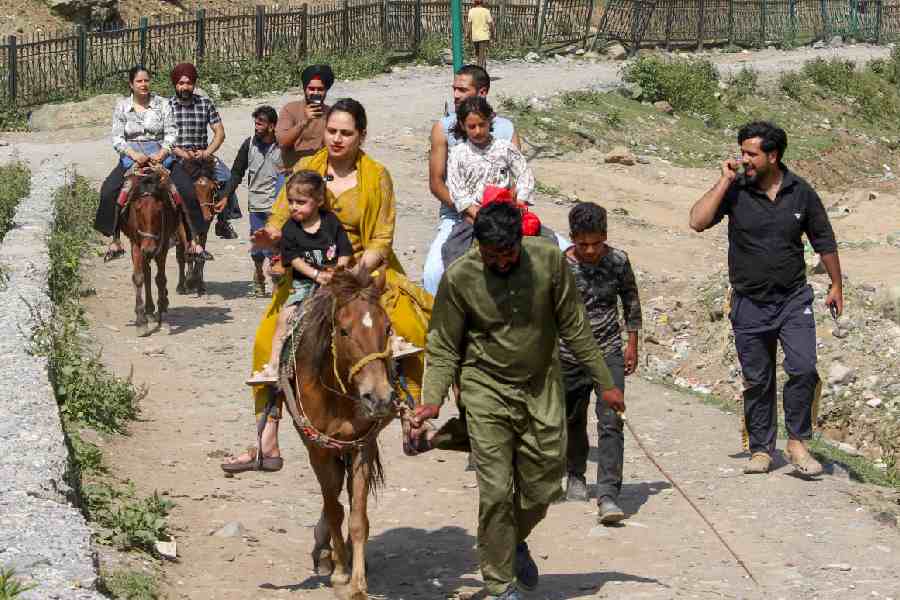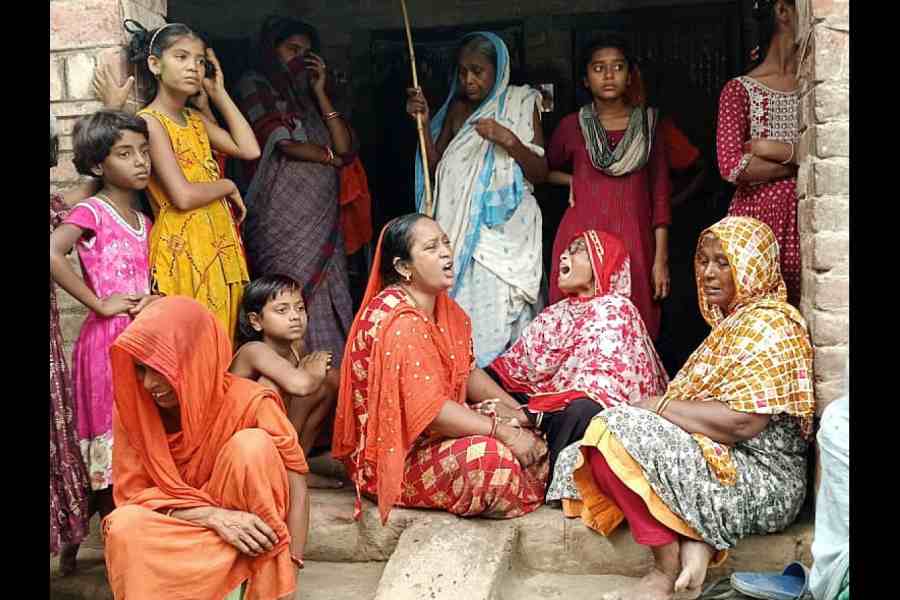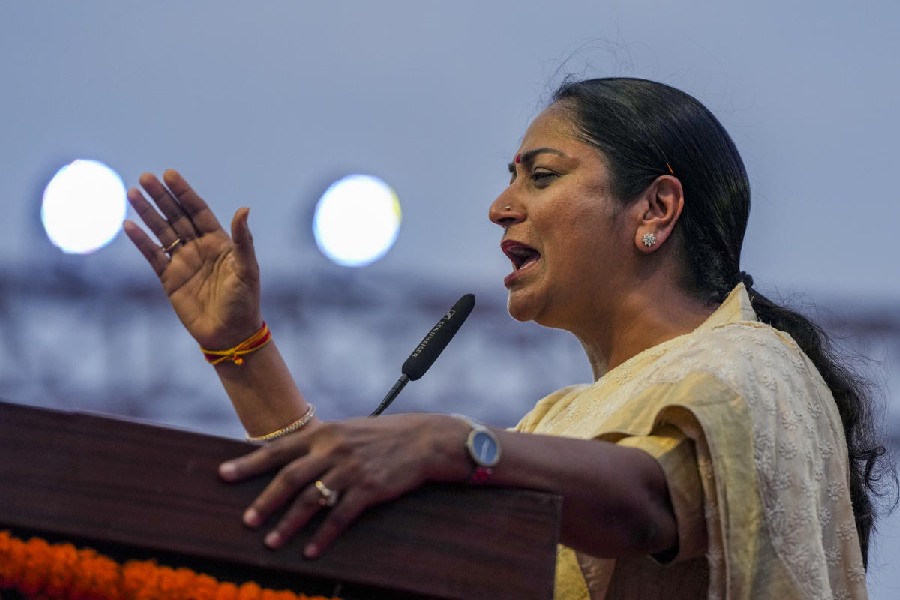|
|
| POINT COUNTERPOINT: Narendra Modi (top) and Atal Bihari Vajpayee. L.K. Advani (below) |
 |
Narendra Modi rarely laughs, unless somebody calls him “Hitler Modi”, the epithet he derives a strange enjoyment from hearing ever since his state, Gujarat, got engulfed in anti-Muslim riots after the murderous attack on the Sabarmati Express in Godhra on February 27, 2002.
Insults, clearly, don’t faze him. When the National Human Rights Commission writ petition on the role of the state government under him during the riots called him a “monster”, he remained unperturbed. Nor did he betray an iota of remorse when the Supreme Court, transferring the Gujarat riot cases to the neighbouring, and Congress-ruled, Maharashtra, described his pack of men in charge of the state as “modern day Neroes”.
It is difficult for him to laugh now, though. For the comparison with Hitler is being aired with increasing defiance by his own partymen. And their protest has found endorsement from Atal Bihari Vajpayee, former Prime Minister and the party’s only leader with a mass appeal. There is a more than marginal chance of the controversial chief minister being fired today itself, at the specially-convened meeting of the BJP parliamentary board. If not, it may drag on till the meeting of the party’s national executive in Mumbai from June 22 through June 24, or even a few weeks after that.
The inscrutable Vajpayee, who changes his views as quickly as his spotless dhoti-kurta, may even let Modi be if there’s a risk of ruffling too many feathers by pursuing him. Facing the collective scowl of partymen yesterday, after descending to Delhi from a holiday in his Himalayan home at Manali, Vajpayee changed tack suddenly as he described the issue of Modi’s removal as one belonging to the past, and urged his supporters to “look at the new year and the new assembly elections”.
Could that also signify a new approach? Certainly, his open declaration, on June 13, that Modi’s leadership was under review, pleased no one in the party. Even Vajpayee loyalists were vocal in their disapproval of their leader’s statement, even going as far as to question its political rectitude.
But, despite the strong bulwark of support within the party that he still enjoys, Modi is no longer the unfailing vote-winner and the leader who cannot be questioned. The revolt against Modi started when 62 of BJP’s 127 MLAs in the state got together recently at the birthday party of the chief minister’s arch-rival Keshubhai Patel’s confidant Dr A.K. Patel and demanded the removal of “Hitler Modi”.
While the dissidents began intense lobbying in Delhi, with Suresh Mehta, their representative and senior leader, camping in the capital to help their cause, BJP’s camp-followers in the NDA, like JD (U) and Chandrababu Naidu’s TDP, also joined the chorus of Modi’s “communal politics” being the cause of the NDA’s poll debacle.
Matters of course took a different turn with Vajpayee firing his salvo from his holiday cottage by the river Beas. In an interview to a television channel, he said he’d have got Modi replaced in the wake of the Gujarat riots, but for others in his party who held “different shades of opinion”. He promised that the issue would be discussed at the national executive in Mumbai. It left the ‘save Modi’ campaigners red-faced.
For Modi, it was worse. His career graph since October 2001, when he was sent to Gandhinagar to replace Keshubhai Patel as chief minister, is marked by stunning successes, and, in its turn, awed reverence from his party colleagues, seniors and peers alike.
When the Godhra massacre happened, with the burning of kar sevaks in a train returning from Ayodhya, allegedly by Islamist militants, the newly elected chief minister (Modi won the by-election from Rajkot three days before the incident) cared little to conduct an objective inquiry.
Instead, he invoked Newton’s third law of motion about each action attracting a reaction which is its equal and opposite. It was interpreted — and was meant to be so, perhaps — as a Hindu jehad with nearly a month-long violence that took a toll of at least 1,000 lives.
Even though there was clear evidence of the pogrom being state-sponsored, with police personnel being seen to guide the murderous mobs in many cities, there was hardly a condemnation from the party’s central leadership. While maintenance of public order is a state matter, the Union home ministry, under L.K. Advani, had ample scope to intervene under the overarching powers given in the Constitution’s Concurrent List. But Advani never uttered a word about Modi’s misgovernance.
Vajpayee now claims that he’d a mind to sack Modi, but, at a meeting of the party’s national executive in Goa, when the matter came up, he yielded to pressure from others, chiefly Advani, gave Modi a glowing certificate and urged him to continue with raj dharma, or the king’s responsibility.
Delhi’s silence, if not acquiescence, made Modi even more defiant. While earning royal eulogies from sycophants, such as ‘Hindu hriday samrat’ (the king of Hindu hearts), he went to the Assembly poll riding the crest of a communal wave. As if to provide fodder to his campaign, the Akshardham temple got attacked by an allegedly Islamist group which the Union government promptly ascribed to Pakistan-based militants.
With the election two months ahead, such coincidence, however tragic, gave Modi the opportunity to build a campaign unparalleled in its bigotry and xenophobia. Every Indian Muslim got identified by him with the “evil general” across the border, “Miyan Musharraf”. Congress president Sonia Gandhi’s foreign origin issue was played up to the frontiers of libel.
The election of course witnessed a landslide victory for the BJP, making some of the ideologues of the Sangh parivar fancy the state as a “laboratory” of sorts for Hindutva. It helped him to have friends in Delhi. For there was none at the Centre to take a call on Modi’s critics in the party and the government, who were complaining of his high-handedness. For the 16 months between the Gujarat Assembly elections and the rout of the NDA government at the Centre, Modi’s word was law in the state.
The Bharatiya Kisan Sangh (BKS), farmer wing of the BJP, which opposed Modi’s policy of sharp tariff increase, got the taste of his ire when policemen evicted it from its office at the MLAs’ hostel. Pleading by bigwigs of the saffron brotherhood, including RSS no.2 Madan Das Devi, did not help.
Gradually the arrogance of power spread to the institutions of state, including the judiciary. The Supreme Court chiding (“…modern day Neroes…”) refers to a string of riot cases in the state’s fast-track courts in which material witnesses were prevented by the police from appearing, charges were given with gaping holes in the prosecution, and, worst of all, with a clear indication that the lower judiciary was neither willing nor permitted to act according to law.
Gujarat under Modi abounded with stories of unexplained murders and vague conspiracy theories. Haren Pandya, former home minister, was assassinated in a park in 2003, after a bitter row with Modi. The killing was promptly attributed to Pakistani militants but the court set the accused at large, saying that there was no case against them.
Vittahal Pandya, the slain leader’s father, has publicly stated that his son had fallen victim to “political vengeance”. In Modi’s 32 months’ rule, at least three convenient police reports of plots to kill Modi have circulated, resulting in no conviction but in five “encounter deaths”, including one last week, in the thick of the ‘remove Modi’ campaign, when Ishrat Jahan Shamim Raza, a 19-year-old college student, and Javed Ghulam Mohammed Sheikh, a 30-year-old father of three, got killed.
While the latter was a Hindu who converted in order to marry a Muslim girl, neither had any terrorist links. State Congress chief Shankarsinh Vaghela, who is a convert from RSS and knows Modi like very few else, calls him a “dangerous man”.
Why is a section of the BJP so keen to save “Hitler Modi”? Why did they confront Vajpayee with something like an ultimatum — it could be a threat to put the blame of electoral defeat on the deficiencies in Vajpayee’s leadership — when the former Prime Minister demanded Modi’s ouster?
Modi’s popularity, however high it’d reigned after the Akshardham attack, is now questionable. Of the state’s 26 Lok Sabha seats, the party under his leadership couldn’t win more than 14. Why is he still so precious to the party?
Embedded in this question is the deeper issue of how the BJP perceives itself in the country’s evolving political equations. If it seeks to jostle for secular space with the Congress, though on a somewhat different pitch as far as economic policy is concerned, it is time for it to shake off Modi. But, after its defeat in the recent election which it fought on a secular plank, nobody in the BJP is confident that it’ll pay to stay secular.
General secretary Pramod Mahajan, never enthralled by Modi, now argues that if Modi had really gone all wrong, how was it that his party did well in the Assembly elections in Rajasthan, Madhya Pradesh and Chhattisgarh? Vajpayee’s waffling also points at a certain diffidence at courting secularism. A philosophy that’s arguably new to the Sangh parivar.
But, if communal polarisation and mobilisation of emotion are the stuff to which the BJP wants to return, Modi is the answer to its prayer. He’s the angel of hell, one who can effortlessly stir up passions powerful enough to combat a crazy-quilt coalition at the Centre. Just one sign of the quilt fraying at the edge, and you’ll hear the familiar high timbre, “Vande Mata Rome” and “Miyan Musharraf”. That’s business as usual, again.











